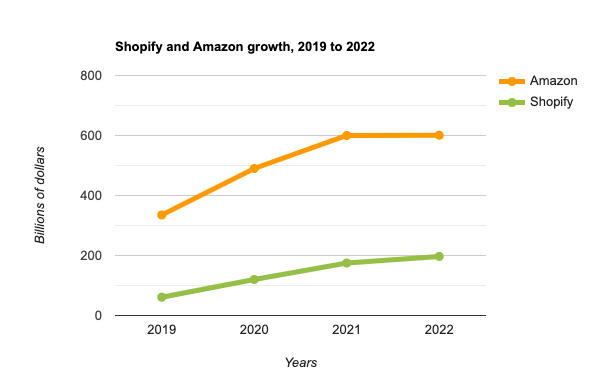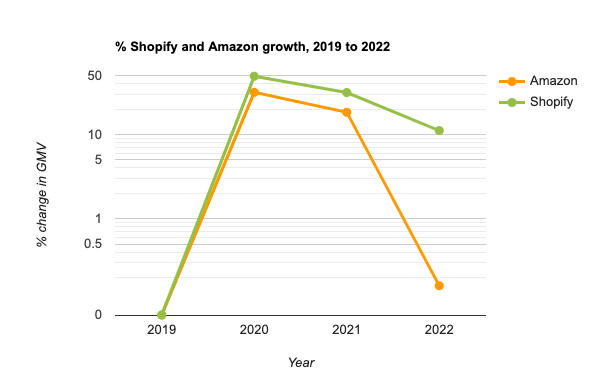In a no-holds-barred knock-down, drag-out cage match between four of the top ecommerce platforms, we feel that Shopify offers the most mature, well-balanced, and economical service to companies looking to sell their products online.

In Big Picture 1, we mentioned what we consider to be the most fundamental attributes of every ecommerce platform: that it be scalable, simple, automatable, and accessible. We also went through why we feel Shopify fits these four requirements really well. In this post, let’s expand the parameters a little bit, and also compare a few of the contenders in the ecommerce industry, and pit them against each other, and against our reigning champion, Shopify.
If you’re in ecommence, there are many tasks you’ll need to check off. You need to present your brand. You need to transact business, including collecting payments, shipping products to customers, and collecting and remitting taxes.
You need to advertise to acquire customers, communicate with those customers, and handle requests from those customers in terms of reorders, subscriptions, and returns. On top of all this, you need to make shopping a pleasant experience that gives you a chance to stand out from your competitors.
Some of Shopify’s competitors meet various of these considerations admirably well. In the final analysis, though, we believe that Shopify does an even better job of balancing them all nicely. But let’s see how they do in the cage!
The Contenders
There are over a hundred viable ecommerce platforms, but we’re only going to throw three of them into the cage today with Shopify in our Deadly Draw.
WooCommerce

Our first contender entered the ring in 2011, spending its formative years in Cape Town, South Africa. From humble beginnings it took the world by storm, running 30% of all ecommerce sites by 2015. But eight years later, does it still have what it takes to win the fight?
In terms of the number of ecommerce sites on its platform, WooCommerce only trails Shopify by a hair. Against Shopify’s 16% of all ecommerce websites on the internet, WooCommerce boasts 13%. That’s a phenomenal number of sites being serviced by WooCommerce – almost 3.4 million!
WooCommerce is basically a plugin for WordPress sites that brings to those sites the ability to sell products right from the WordPress site. Since WordPress powers more than 43% of all websites on the internet, having a way to add ecommerce abilities to these sites is quite attractive.
It’s easy to see the advantage a company would find, having spent ten or fifteen thousand dollars to build their website, if they could convert that website from an informational one into one that could sell products.
Although it’s true that WooCommerce technically adds some ecommerce features to a regularly created WordPress site, we don’t find this the most effective strategy for doing so. Bolting on ecommerce functionality to a site designed for something else ends up always feeling sort of like the afterthought that it is, both for the site owner as well as for the visitors.
Website owners likely look to add ecommerce options to their regular site so they can give their customers a seamless experience. This is a good idea, but unfortunately, WooCommerce often ends up feeling pretty seamy.
The fact that WooCommerce is nominally free may cover a multitude of niggling problems for many website owners, though in the final analysis, the owners may not come up on top as far as cost goes, as they’ll need to cover hosting and domain registration, payment for a theme that’s optimized for WooCommerce and probably for development work done by a competent agency.
Financially speaking, they may come out on top with WooCommerce, particularly if they do everything themselves. On the other hand, they could easily end up spending more to integrate WooCommerce into their existing site than setting up a separate but connected shop through Shopify, with its known monthly price.
Wix

Our second contender hails from Tel Aviv where it started fighting on the streets as a company website builder in 2006. Five years later it moved into the ecommerce ring as it began adding selling abilities to its sites. Now in 2023, having 8.5 million live sites, it’s the undisputed champion of the website builder space, but does it have what it takes to claim the title for ecommerce as well?
Wix was started to just provide a way to simply create a business website. While website creation may have been the impetus, Wix quickly moved into the ecommerce provider space by adding selling functionality to its sites. I suppose this makes sense as most companies are selling things in one form or another.
As an all-in-one solution, with Wix you won’t have to worry about hosting or domain registration or any of the things WooCommerce requires you to do, as all of that is taken care of by the platform. And in terms of the look and feel of the site, the sky’s the limit as you use Wix’s fairly intuitive What-You-See-Is-What-You-Get editor.
In some ways, this is a bit of a blessing and a curse, though, as designing your site in whatever way you envision it may actually end up giving you a site that gets in the way of achieving your visitors’ goals.
With Shopify, out of the box, you may not have the site exactly as you’ve envisioned it, but you’ll have one that follows the standards of whatever theme you’ve selected, and it’s likely that that theme is optimized for the task of buying and selling, so will get in your customers’ ways far less than a hurley-burley version from your own mind.
On top of this, there are still quite a few aspects of Wix that make it clear that though ecommerce capabilities were added to the platform a long time ago and so are fairly mature, they’re still ultimately kind of an afterthought, or an ancillary purpose. In his analysis, SiteBuilder Report’s Juhil Mendpara points out that in shipping, fulfillment, payments, taxes, and other business essentials, Wix’s offerings are much less robust than Shopify’s.
Add to this the fact that to get access to the limited business abilities of Wix requires the Business Basic plan, which is $27/month, only $2 less per month than the Basic Shopify plan, and many of Wix’s advantages evaporate.
Amazon

Our third contender’s crooked smile is the only introduction it needs. Amazon started its fight to the top in a garage in Bellevue, WA back in 1994, and has dominated the competition in the online selling world. But how will it do in the ring as an actual ecommerce platform against our other contenders?
For folks who want to focus on their products and do the least amount of work to get them online, Amazon seems like a great option. It’s cheap to get started, you can sell practically anything, and you’ll have a huge audience.
Amazon’s pretty much the biggest online selling player in town: Amazon moved about $600 billion worth of products in 2021, and about the same in 2022 (). Shopify, on the other hand, moved $175 billion in 2021 and $197 billion in 2022.
Though Shopify had 11% growth in a year Amazon pretty much remained flat, the fact of the matter is that Amazon is still selling about three times as much as Shopify is, so it’s not a bad idea to sell through Amazon.


Further, since everything’s on their platform, you don’t have to worry about hosting, domain registration, hiring a developer, or anything like that. All of these things are significant benefits, but there are some significant disadvantages to selling on Amazon, as well.
One of the biggest disadvantages is that opening up an Amazon store gives you very little opportunity to customize your store and make it stand out from your competitors. You can add your logo and choose from a few different section layouts, but ultimately you’re stuck with a shop that looks pretty much like every other store on Amazon. It works. It’s efficient, especially since everyone knows how to use it. Unfortunately, it’s kind of sterile and boring.
Furthermore, though it’s no fun to have to pay for domain registration every year, and hosting fees every month, doing that allows you to have your own domain name that you can point people to, which is a pretty considerable benefit. “Just go to grayl.com!” comes off much better than, “Just go to amazon.com/stores/grayl…”
Besides this, since Amazon handles the majority of customer communication, with this option you don’t have much chance to do many of the things that will build brand loyalty, like email campaigns or SMS marketing/relationship building, as we talk about elsewhere in this Big Picture series.
It’s really easy to sell things on Amazon, but it’s much harder to build your brand there, which is ultimately more important if you want to grow your business rather than just sell products.
And the winner is…

You know already that we think Shopify is the best way to go for your online store. It’s the biggest online platform for standalone ecommerce stores, and with really good reason. It’s purpose-built for ecommerce, making it an easy all-in-one solution.
Amazon may do well at selling, Wix may do well at turning the vision of a website into reality, and WooCommerce may do well at bolting on some ecommerce functionality to an already-built WordPress site, but for overall ecommerce and business growth, Shopify knocks all of them out of the ring.

